town hall
town hall
High Street
There had been an early form of Town Hall, the Tolle Hall, in the Borough for generations, as well as Butcher's Shambles and Market House. This latter was described as "70 feet long and 20 feet wide, supported by 20 stone pillars, and in the middle of it are the remains of an ancient cross; there are also several rows of shambles."
By the middle of the nineteenth century the old building was in a bad state of repair and was deemed inadequate for the growing town. Consequently, a plan for a new Town Hall and Market, dated 18 July 1836, was drawn by a Taunton surveyor, Richard Carver. It provided for a Corn Exchange with an Assembly Hall above it, and in the rear a market for provisions and other goods.
The building would have been set back from High Street, behind a screen of columns with a carriage entrance leading up to a portico. A large vestibule gave access to a Corn Exchange 60ft by 40ft, and to a slightly smaller covered market for butter, poultry, eggs, bacon, and cheese. Between this building and South Street was an open market for flax and general goods, surrounded on three sides by a colonnade for butchers’ stalls, with an iron palisade on the street front and access for the public. Above the Corn Exchange was an Assembly Room with a balcony above the entrance portico for making announcements. Ten rooms opened from the Assembly Room, together with a dining room for formal occasions. It is clear that it would have been an imposing and commodious Town Hall to replace the dilapidated Tolle Hall or Court Chamber, Shambles, and Market House in the Borough.
In 1846 the Special Commissioners took over the rights to the markets from the Phelips family, and they resolved to build a new Town Hall and markets that would also replace the old Tolle Hall, the Shambles and the Market House, all in the Borough. They bought several properties for the new site, including premises belonging to, or occupied by, Thomas Binford, Esq., Mr George Crocker, ironmonger, James Curtis, saddler and harness maker, a portion of the King's Head Inn (which already belonged to the Corporation), and a court called George Court. The Western Flying Post commented that “by destroying George Court, they will get rid of a great nuisance”. As it turned out, George Court was not demolished until the mid-1920's when King George Street was built.
The new Town Hall was designed by Thomas Stent and built by John Rawlings in just over a year. It cost around £4,000 (about £420,000 at today's value). Daniel Vickery reported “On Tuesday, June 19, 1849, the Town Hall and Market House were inaugurated with a splendid banquet, given in the large Hall of the building, when it was supposed upwards of 3000 persons walked through the building.” Guests at the banquet, presided over by George Harbin and Dr Tomkins, included William Matthews the Portreeve, William Edwards the senior Burgess, Burgesses James Curtis and John Moore and the Clerk to the Special Commissioners, James Tally Vining. That the new Town Hall was completely out of scale and character to the existing streetscape didn't really matter to the Victorians, provided it showed off the leading townspeople's aspirations towards grandeur.
The new building, faced in Ham stone, had a rusticated ground floor at street level with six arched pillars. Much of the ground floor, open to High Street via these arches, was devoted to market stalls. Above the pillars and arches, the facade of the building sported Grecian Ionic columns, pilasters and entablature. This was surmounted by a cornice with a circular opening intended for a clock, which was installed later. The whole elevation to High Street was 62 feet (18.9m) across. The first floor was reached by a flight of stone steps with cast iron balustrades. Inside was a large hall 58 feet long, 35 feet wide and 22 feet high (17.7m x 10.7m x 6.7m) lit by five large windows and had two gas-lit chandeliers. The cost of the project was about £4,000.
At the same time, and behind the Town Hall, were built a Corn Exchange, Meat Market and a Cheese Market, the whole complex extending from High Street all the way to South Street as shown on the map below. The market stalls on the ground floor were removed in 1868 and replaced by shops.
A clock with four faces had a large bell for striking the hour and two smaller bells for striking the quarter hours. The clock was purchased by Yeovil clockmaker Robert Dobell from clockmaker James W Benson of Ludgate Hill, London, although Dobell ensured his name was engraved on the clock faces. The clock was installed in 1863 in a tower designed by a local architect, Charles Benson.
In its edition
of 8 December
1863, the
Western Flying
Post
reported; "The
New Town Clock.
The inhabitants
of Yeovil have
long been
anticipating the
convenience of a
turret clock in
a tower at the
Town Hall. On
Friday last,
being the day
for the holding
of our annual
cattle show, the
clock, with its
illuminated four
dials, was for
the first time
publicly
announced as
complete. We
have to
congratulate our
fellow-townsmen
that so good an
horological
monitor has been
obtained
economically.
The clock has
been constructed
by Mr Dobel,
watch and clock
maker, Yeovil,
upon the
simplest
adaptation of
large
timekeeping
construction,
combined with
the most
effective
principles of
measuring and
proclaiming
time. The clock
itself is
powerful, and
fully capable of
striking bells
of even larger
size, also of
showing time
upon dials of
increased
diameter. The
most important
and imposing
feature in the
whole work is
the beautiful
effect of the
illuminating
dials which so
closely
approximates in
chasteness and
perspicuity to
the appearance
by night of the
dials off the
Houses of
Parliament. Mr
Dobel has
succeeded in
giving that
pellucid surface
and has used the
same medium, or
if not the same,
that which
produces equal
effect, so that
we may safely
affirm that in
or out of
London, the
nearest approach
to the effect of
external dial
lighting
attained at the
palace at
Westminster, is
at the Town
Hall, Yeovil.
The wheels of the clock are composed of gun metal of unusual hardness. The great wheels are 15 inches in diameter, and controlled in their operations by an escapement upon the dead beat principle, having a two-seconds pendulum rod, 14ft in length, with a pendulum ball of 1 cwt. The striking parts are upon an improved principle. Each dial plate is 5ft 6in in diameter, and weighs 2 cwt 10 lbs. The large hammer, which strikes the hours weighs 25 lbs, those which strike the quarters are, of course of lighter weight. The cast-iron frame of the clock weighs 5 cwt, and the whole of the machinery, dials, &c, weighs 30 cwt.”
During 1864, the clock weights fell through the town hall ceiling. One of the weights became embedded in the dance floor, while the other, heavier, weight burst through the floor and became lodged in the ceiling of the market below. In 1865, concerns were raised concerning the structural instability of the clock tower. Other reports recalled issues, such as the clock movement stopping due to the weight of snow on the hands and high winds smashing the dials. By 1887 surveyors declared the clock structure unsafe, blaming poor design and unsatisfactory materials and the clock tower was taken down in 1887.
A temporary clock was made by Yeovil watch and clock maker William Cox, and installed in 1888 by John Tyte. The new clock was a double-sided dial drum clock affixed above the Town Hall entrance (see Gallery). The dial had the name Cox, Yeovil, on it. Tyte was in partnership with Yeovil jewellers and silversmiths Messrs Hancock, Cox and Co from 1874. In 1897, the partnership between Tyte and William Cox was dissolved by mutual consent. Tyte continued the business but sold it in November 1898, following the death of his wife. The drum clock was later stored, and the movement was used in the clock that surmounts the newly-built Reckleford school in 1916 - where it remains to this day (albeit not working at present).
The town hall clock tower was replaced in 1912 (see Gallery) with a new steel-framed structure that was designed to evenly distribute the great weight of the clock tower, its gas-illuminated clock and the heavy bells. From the Chaffin CDV illustrated below, it appears that the 1912 tower was an almost exact replica of the first tower, removed in 1887.
The new clock was a gift to the town donated by Thomas William Dampier-Bide and his sister Bessie, of Kingston Manor, to commemorate the coronation of King George V as described in the article below.
|
The
following
article
is from
the
Western
Gazette
of 12
April
1912
Yeovil's Coronation Memorial
We are able this week to give an illustration of the appearance of Yeovil Town Hall when the new clock turret, now in course of erection, is completed. It will probably be remembered that when the first meeting was held to consider the best means of locally celebrating the Coronation, and the question of a permanent memorial came up, there was a suggestion that in view of the lack of a public clock showing the time in the centre of the town, a new public clock might be erected. The suggestion, however, although supported, was shelved in favour of the scheme for the removal of the premises in the Borough in front of the Parish Church, which ultimately fell through. It was while these negotiations for this purchase were in progress that Mr TW Dampier-Bide of Kingston Manor, wrote to the then Mayor (Ald. E Damon) to the effect that he and his sister, Miss Dampier, were prepared to bear the cost of the erection of a clock turret on the Town Hall as a memorial of the Coronation, at a cost of £300, which it had been stated would be the sum required. The Corporation had some time previously discussed the possibility of the re-erection of a turret in the place of the one removed some 25 years previously, having still in their possession the clock and the bells on which it chimed and struck, and Mr Dampier-Bide's offer was at once accepted, with thanks, by the Town Council. The work, which has now commenced, and is being carried out from plans by Mr Arthur Oddy, the borough surveyor, in conjunction with Messrs John Petter & PF Warren ARIBA, architects of Yeovil - who specially made for publication in this paper the drawing from which our illustration was made - includes also the reconstruction of the attic storey of the Town Hall, which would have been absolutely necessary even if the clock turret had not been erected. As will be seen the turret is in the centre of the façade, and will contain the old clock, which is in excellent condition, and the necessary chiming bells. There will be four dials, each about six feet in diameter, and the top of the turret will be nearly 100 feet from the pavement, so ensuring the clock being seen from many parts of the town. The total cost of the whole work will be about £524, of which Mr Dampier-Bide and Miss Dampier will pay the £300 promised. The contract time allowed for completion is four months.
|
The Town Hall was destroyed on 22 September 1935 by a fire believed to have been caused by paper rubbish blowing into the clock tower and ignited by the gas jets illuminating the clock. The building was completely gutted, causing thousands of pounds worth of damage, including the loss of two paintings hanging in the Council Chamber. The paintings were a portrait of George IV by Sir Thomas Lawrence and the muster of the Earl of Bedford's forces in the parish churchyard by Dorset artist Francis Newberry. The combined value of the two paintings was £1,500 (£245,000 at today's value).
|
The
following
article
is from
the
Daily
Mirror
of 23
September
1935
Famed Town Hall RazedRoof and Clock Tower Landmark Crash Yeovil's famous old town hall, a fine building in the Georgian style, was burned out early this morning. The outbreak was discovered by Police Constable Udall, who noticed smoke coming from a corner of the roof. Yeovil fire brigade was summoned and for nearly five hours fought the blaze with hoses from both sides of the building. A series of gas explosions inside the building added to the difficulties of the brigade, and a Corporation Gas Department employee, Mr S Swetman, was overcome while trying to cut off the gas and had to be carried out by firemen. After receiving first aid he was taken home. The building blazed furiously, and it was soon seen that there was little hope of saving it. The roof crashed on to the ballroom floor with a terrific roar, and a few minutes later the clock tower - a famous landmark - also fell. Guests at the Mermaid Hotel, near by, sat at the windows in their night attire, watching the fire. The town hall is in the centre of Yeovil's shopping area, and it was only due to prompt work on the part of the Yeovil brigade that the Justices' Courts, municipal buildings and large business premises were not involved. The damage amounts to thousands of pounds. Two valuable paintings presented to the town, one a 12ft high oil painting of King William IV and the other a painting of troops in Yeovil Churchyard before the battle of Babylon Hill, were destroyed. The fire is believed to have started in the roof. Its cause is a mystery.
Councillor R Pittard holding part of the clock recovered from the debris in the dance hall below the clock tower, after Yeovil (Somerset) Town Hall, a fine old building in the Georgian style, had been burnt out early yesterday.
|
The only remains of the Town Hall, a small section of wall, may be seen today in Borough Arcade.
MAP

The 1886 Ordnance Survey showing the Town Hall & Market House, the Corn Exchange, Meat Market and the Cheese Market.
gallery

A celebratory sketch dated 1850 of the Town Hall and Market House that opened the previous year. The clock, illustrated here in the pediment, was a bit of wishful thinking as the actual clock was not installed until 1864 and even then wasn't set into the pediment as shown here, but mounted in a short tower so that all four faces of the clock could be seen.

Can you imagine what would happen today if the Council said that all the shops in town were to close at 3pm for a dinner?
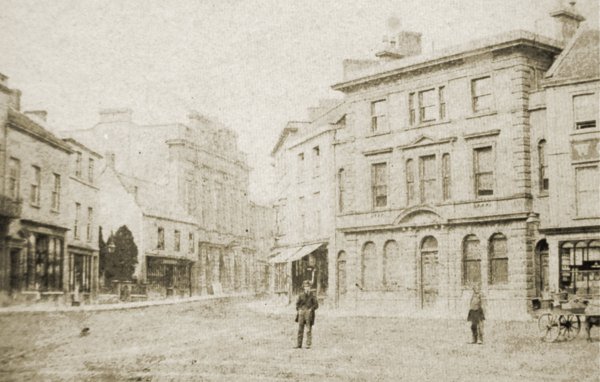
A very early photograph, taken in 1863 by William Barrett, shows High Street as seen from the Borough. Notice that at this stage the Town Hall lacks a clock tower which was not to be erected until 1864.

From my
collection
 From my collection |
The carte de visite above is, I believe, the only known photograph of the Town Hall with its original clock tower - enlarged at the left. It was taken by Yeovil photographer John Chaffin and, from the style of the back of the CDV and other subtle clues in the photograph, was taken in early 1868, when he was working alone and before his son Thomas became a partner in the business that became Chaffin & Son in 1869. The clock tower seen here was declared unsafe in 1887, and was dismantled that same year. A new steel-framed clock tower was erected in 1912, designed to evenly distribute the great weight of the clock tower, its gas-illuminated clock and the heavy bells. Comparing this first clock tower with the later version, it would appear that the later tower's design was based on that of the former, although there are very minor differences. |
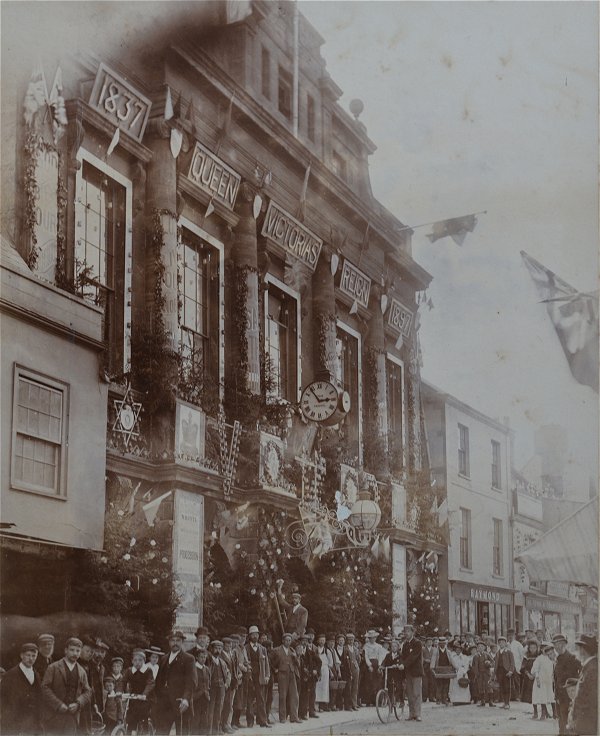
Courtesy of Bill and Audrey Robertson
The Town Hall photographed in 1897 when it was decorated to celebrate the Diamond Jubilee of Queen Victoria. The photograph is by John Bell of Yeovil.
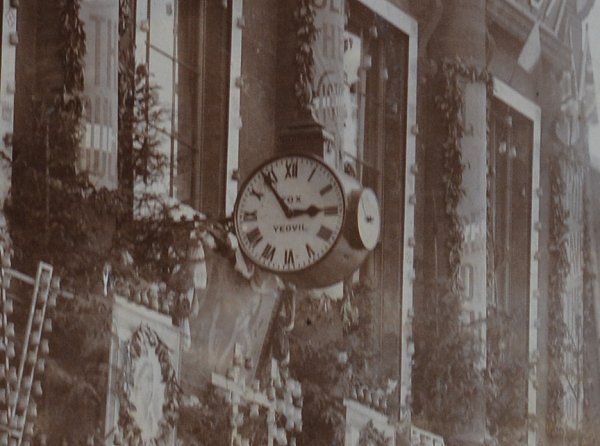
An enlargement from the previous photograph shows the temporary drum clock erected by the Council. Thanks to Al Cobb for informing me that Council minutes note that a temporary drum clock was discussed in 1888 which resulted in this clock over the entrance to the Town Hall.
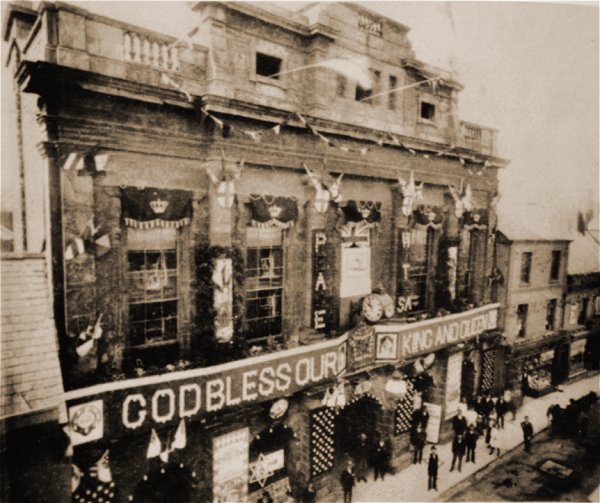
The Town Hall photographed in 1902 when it was decorated to celebrate the coronation of Edward VII.
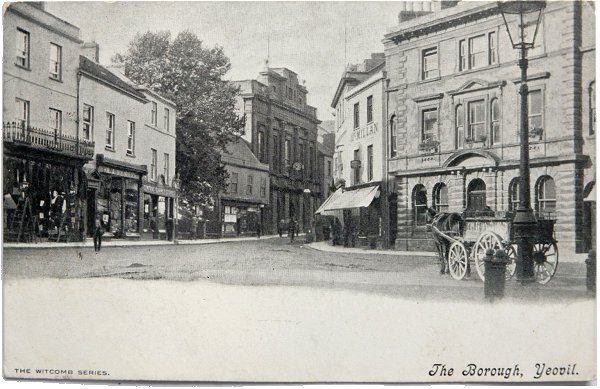
From my
collection
-
This photograph
features in my
book 'Yeovil
From Old
Photographs'
High Street, looking from the Borough. This postcard was sent in 1905.
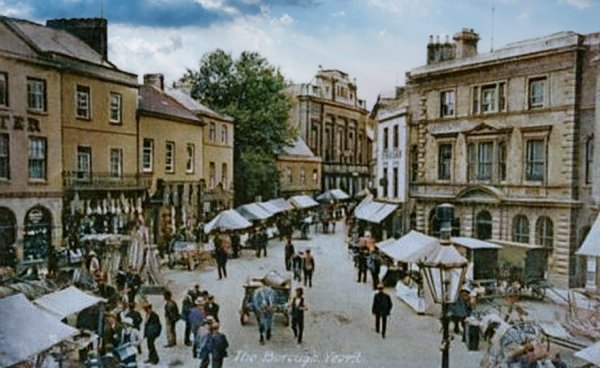
From my
collection. This
colourised photograph
features in my
book 'Secret Yeovil'.
A postcard of about 1905 (this one was posted in 1911) showing the Town Hall beyond the weekly market in the Borough.

A heavily hand-tinted postcard of the Town Hall, Borough and High Street dating to about 1907.
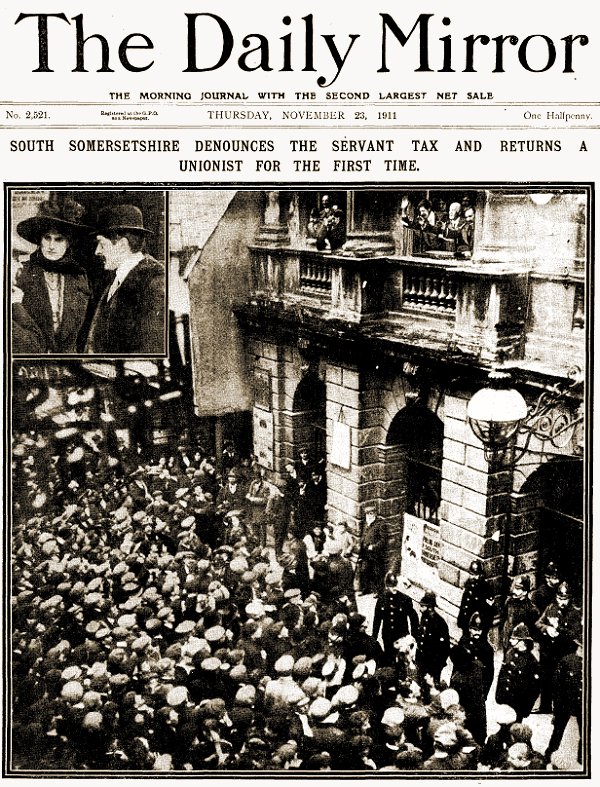
Courtesy of Rob
Baker.
This photograph
features in my
book 'Secret
Yeovil'
The front page of the Daily Mirror of 23 November 1911 showing crowds gathered outside the Town Hall. The caption reads "A Liberal stronghold, South Somerset has been captured by the Unionists. The campaign centered almost entirely around the Insurance Bill, and the electors have shown their dislike of that measure by returning the Hon. Aubrey Herbert by a majority of 148 over Mr Herbert Vivian. The constituency has been represented since 1892 by Sir Edward Strachey, whose elevation to the peerage necessitated the by-election. The large photograph illustrates the scene at Yeovil Town Hall at the declaration of the poll yesterday, and shows the Returning Officer at the window, with the new member and the defeated Liberal on either side. The small photograph shows Mr and Mrs Herbert. Mr Herbert, who is a half-brother of the Earl of Carnarvon, fought a strenuous campaign against Lord Strachie in both January and December of last year. On each occasion he succeeded in reducing the Liberal majority."

Workers in a colourised photograph taken during the construction of the new clock tower in 1912 - clearly before the days of Health & Safety. The new clock tower was all but identical to the earlier tower, removed as unsafe in 1887.
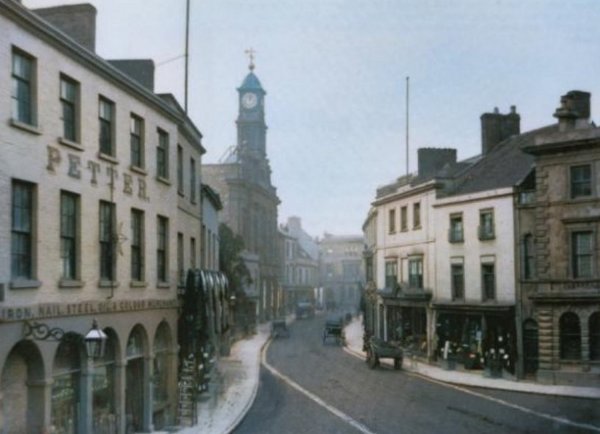
This colourised photograph of High Street dates to about 1914, by which time the Town Hall clock tower had been built. The building at the far end is Stuckey's Bank that predated the present bank building (somewhat out of proportion with the rest of the building and streetscape in my opinion).

Courtesy of Jack
Sweet
The Town Hall photographed from the Borough around 1914.
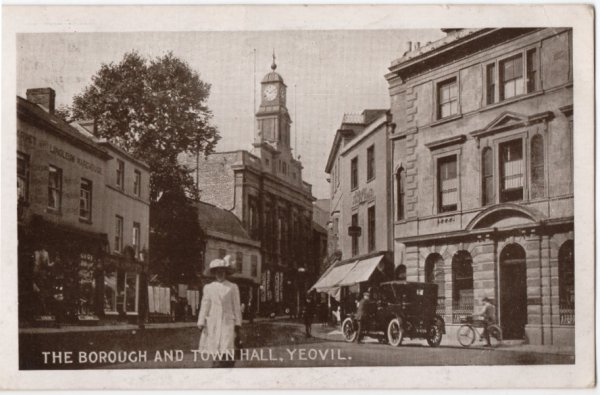
From my
collection
A postcard looking towards the Town Hall from the Borough. This card was posted in 1918.

From my
collection
-
This photograph
features in my
book 'Yeovil
From Old
Photographs'
A hand-coloured postcard (usually seen in monochrome as the previous) showing the Town Hall seen from the Borough around 1918.
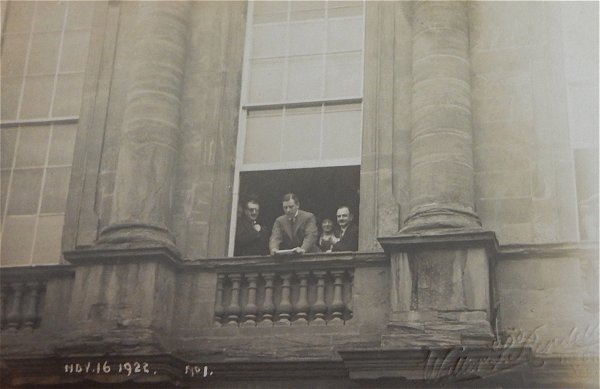
Courtesy of
Betty Barber
(née Bird)
The election results are announced from the Town Hall to the waiting crowds in High Street on 16 November 1922.
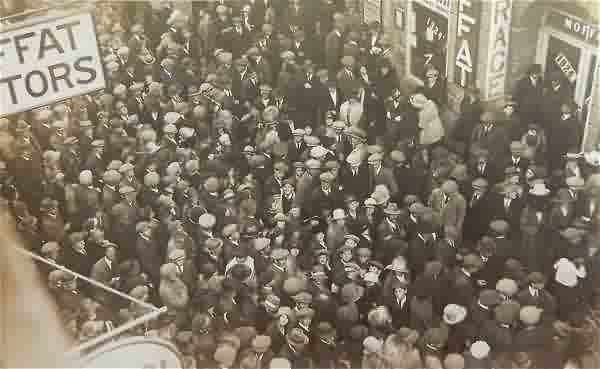
Courtesy of
Betty Barber
(née Bird)
The crowd waits in High Street for the 1924 election results. At top right the Moffat Garage advertising is on a pillar of the Town Hall. The sign of Moffat Motors at top left is on James Moffat's shop opposite the Town Hall.
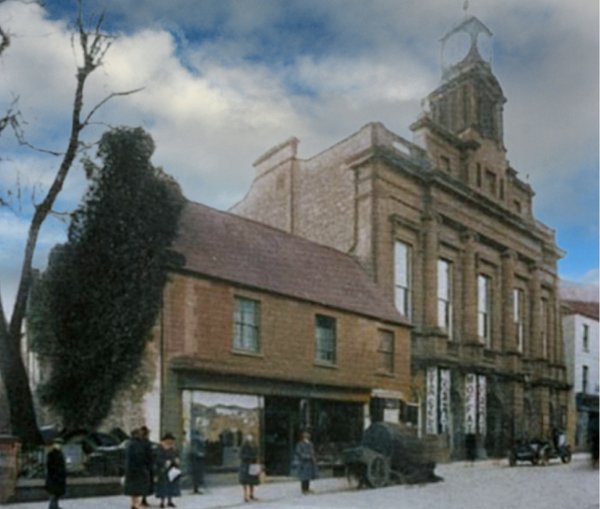
This colourised photograph of 1925 shows the arched ground floor, originally open to the air and used for market stalls but by this time enclosed and used as shops.
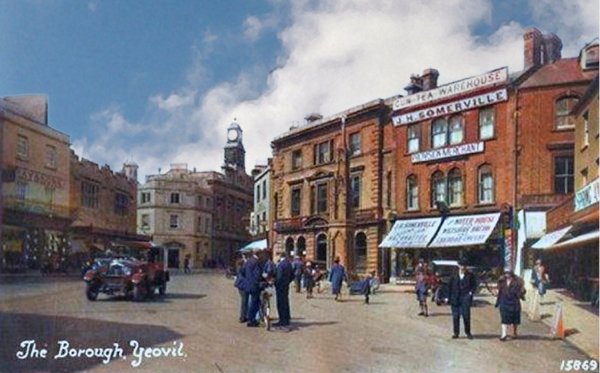
From my
collection
A colourised postcard dated 1929 looking across the Borough towards King George Street. Note that the town hall now has its clock.
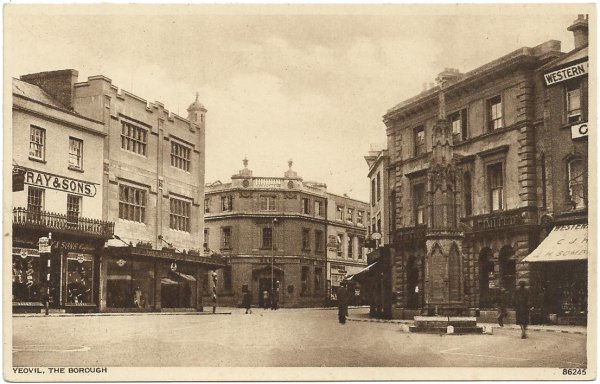
But in an almost identical postcard dating to after 1935, the town hall has disappeared, being destroyed by fire.

Courtesy of Bill and Audrey Robertson
Damage after the fire, seen from the roofline and as shown in the Daily Sketch on Monday 23 September 1935.
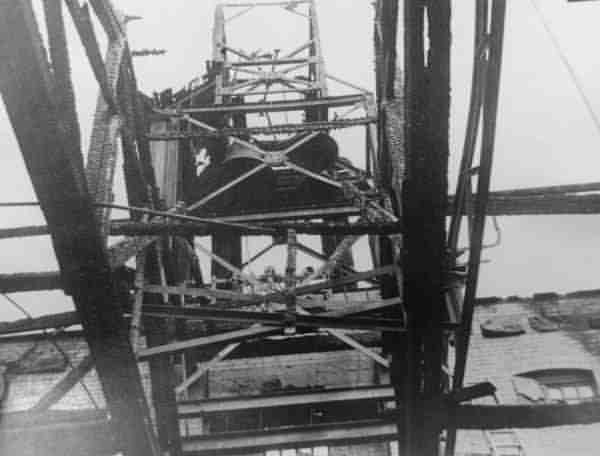
Damage caused by the fire in September 1935 - the building was completely gutted. This photograph looks up to the remains of the clock tower and the bells for striking the hours and the quarters are just discernible.

Courtesy of Rob
Baker
A similar photograph of the clock tower remains from the Western Daily Press & Bristol Mirror's edition of Monday 23 September 1935.

Surveying the damage after the 1935 fire.
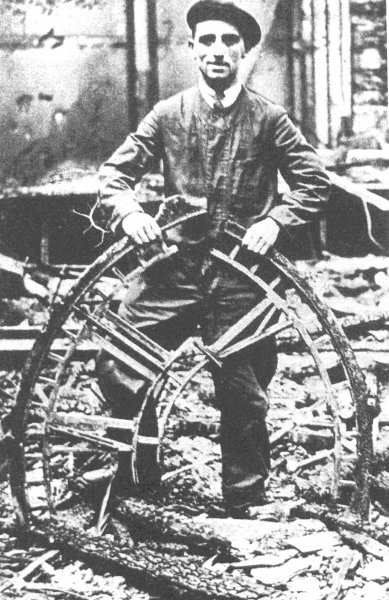
The remains of the town hall clock are displayed by a workman after the fire.
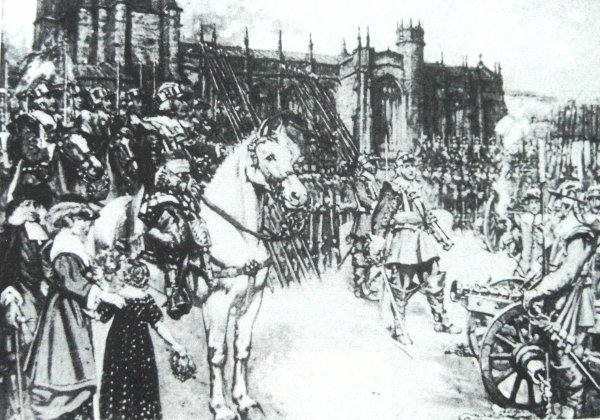
One of the paintings lost in the fire, "The muster of the Earl of Bedford's forces in the parish churchyard" by Dorset artist Francis Newberry (1855-1946), later director of the Glasgow School of Art, 1885 to 1917.
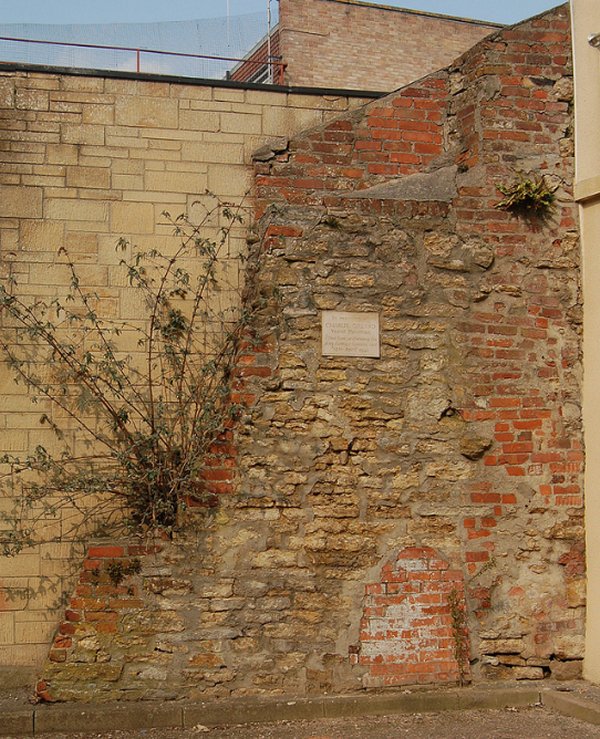
The last remains of the Town Hall in Borough Arcade. Photographed in 2013. The plaque is in memory of Charlie Gillard, a reserve fireman killed during the Second World War.

